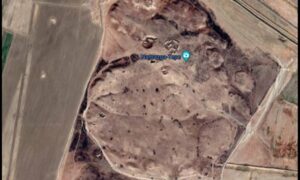Namazga-Tepe, an archaeological site located in Turkmenistan, approximately 100 km east of Aşgabat and near the border with Iran, stands as a testament to the Bronze Age Bactria-Margiana Archaeological Complex (BMAC). The site has been the focus of extensive excavations since the 1950s, led by notable archaeologists such as Vadim Mikhailovich Masson, Viktor Sarianidi, and I. N. Khlopin. These efforts have significantly contributed to the understanding of the Bronze Age chronology in Turkmenistan, particularly for the periods Namazga III-VI.
Namazga Culture
The Namazga culture, flourishing in what is now southern Turkmenistan, represents a significant chapter in the ancient history of Central Asia. This culture, spanning from approximately 5300 to 1000 BC, showcases the evolution of human society from neolithic villages to complex urban centers. The timeline of the Namazga culture can be divided into several phases, starting with Namazga I and II, characterized by early agricultural settlements, and culminating in the urban sophistication of Namazga V and VI, which saw the emergence of proto-urban centers.
One of the major moments in the development of the Namazga culture was the transition from Namazga III to Namazga IV (around 3000 BC), marking the shift from simple village life to more complex societal structures. This period witnessed the introduction of metalworking, the expansion of trade networks, and the development of craft specialization, laying the groundwork for the urbanization that defined the later stages of the culture.
Religion played a significant role in Namazga society, with evidence suggesting a belief system that venerated natural forces and fertility deities. Archaeological finds, including terracotta figurines and ceremonial objects, indicate that rituals and religious practices were integral to their daily life. These artifacts, often found in residential areas, suggest that religious practices were not confined to a priestly class but were a part of everyday life.
The social and daily life of the Namazga people was marked by a high degree of organization. The layout of Namazga settlements, with their distinct residential and communal areas, reflects a structured social hierarchy. Agriculture was the backbone of their economy, with irrigation techniques being developed to support crop cultivation in the arid environment. Animal husbandry, particularly of sheep and goats, played a secondary role.
Information about rulers, kings, or queens within the Namazga culture is scarce, as written records did not exist, and archaeological evidence does not clearly indicate a centralized political structure until the later phases. However, the complexity of the urban centers and the existence of monumental architecture suggest the presence of a ruling elite or priestly class that wielded significant power.
The Namazga people were indigenous to the Kopet Dag region, exploiting the fertile river valleys for agriculture while also engaging in long-distance trade with neighboring regions. This trade, particularly in metals and precious stones, facilitated cultural exchanges and contributed to the cultural richness of the Namazga.
While there is limited evidence of wars and battles involving the Namazga culture, the construction of fortified structures in some settlements suggests a need for defense against external threats. The decline of the Namazga culture around 1000 BC is not well understood but may have been influenced by environmental changes, economic difficulties, or invasions by nomadic tribes.
In conclusion, the Namazga culture represents a critical period in the development of civilization in Central Asia, showcasing the transition from simple agricultural communities to complex urban societies. Despite the lack of written records, archaeological evidence provides a window into their advanced social organization, religious practices, and economic activities, offering valuable insights into the evolution of human societies in the ancient world.

